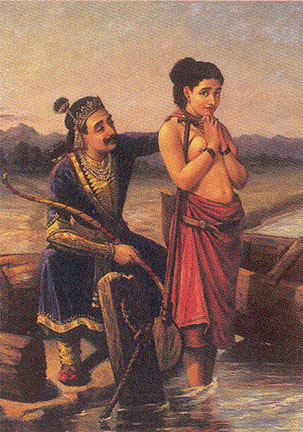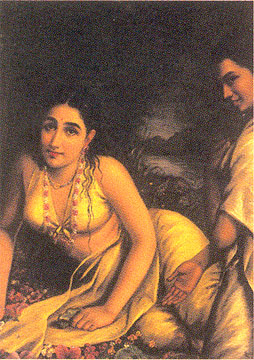Dec 24, 2025
Dec 24, 2025
 It is Indi-pop time on MTV. The song by rising star Phalguni Pathak opens with a svelte woman walking out of a painting. What follows is a seductive unveiling to the number 'Meri Chunar Ud Ud Jaaye' (My veil keeps flying away). The painting is by none other than the famed and damned Raja Ravi Varma (1848-1906). His portrayal of Shakuntala is the inspiration for the pop music number.
It is Indi-pop time on MTV. The song by rising star Phalguni Pathak opens with a svelte woman walking out of a painting. What follows is a seductive unveiling to the number 'Meri Chunar Ud Ud Jaaye' (My veil keeps flying away). The painting is by none other than the famed and damned Raja Ravi Varma (1848-1906). His portrayal of Shakuntala is the inspiration for the pop music number.
The women painted by the Raja have never been as much in demand in the art market as they are today. The revival took place in the 1990s with international auction houses like Christie's and Sotheby's showing a great deal of interest in his works. Then came the big-time art dealers and small antique shops selling crude representations of his works or prints supposedly credited to the Chitrashala Press founded by him.
What all these people are catering to is an immense interest in the works of the Raja. Clearly it is 'in' to possess a Ravi Varma. If not in the original form then even a pirated one will do. In fact, Varma is one artist who was the greatest victim of piracy in his lifetime.
Ask Almona Bhatia, who thrives on selling prints and oleographs by Varma on the web, on what she thinks of the representation of women by the artist and she is quick to gush, "They are just wonderful: His Mohini, his Damyanti, his Shakuntala and so many others. He paints a woman as the seductress and temptress. What more can one ask for? And these sell like hot cakes."
 This is an honest remark given the post-feminism phase and times that are so guided by market forces. But ask a senior woman painter like Arpana Caur and the response is very different. Says she, "I have never liked the representation of women by Varma. It is too calendar-like. Women in his works are much like the ornaments they wear. They are either idealized or turned into objects of desire with their clinging wet saris. These are not down-to-earth women who work like you and me."
This is an honest remark given the post-feminism phase and times that are so guided by market forces. But ask a senior woman painter like Arpana Caur and the response is very different. Says she, "I have never liked the representation of women by Varma. It is too calendar-like. Women in his works are much like the ornaments they wear. They are either idealized or turned into objects of desire with their clinging wet saris. These are not down-to-earth women who work like you and me."
In fact a decade ago, well-known Mumbai-based painter Nalini Malani had picked a quarrel with Varma and gave expression to it through a painting called 'Re-thinking Varma'. This was a strong reaction to his painting, 'Galaxy of Musicians'. Pushing Varma's musicians to the margins of the canvas, Malani instead has youthful full-bodied women and a powerful mother figure occupying centre stage.
Varma's women are generally laden with ornaments and follow the colonial stereotypes of oriental femininity. The rich costumes, ornate jewelry and lavish backdrops are all designed with a special appeal. It is exotica at its best and it still continues to excite the western eye. And the eastern eye is quick to ape the west.
Says Pran Neville, author of books like 'The Nautch Girls of India' and 'Beyond the Veil -Indian Women in the Raj', "His women, be they goddesses or village belles, are not true to life. They are what an ideal woman should be. And as far as the embellishment of women goes, he surpasses all artists in the East or the West."
Caur on the other hand says, "His women are decorated like Christmas trees." There are several Varma opponents among the intelligentsia. Senior painter Ghulam Mohammad Sheikh says that thousands of works have given him sensuous pleasure and have stayed in his consciousness but not a single one of these has been painted by Varma.
A balanced appraisal of Varma's representation of women comes from Gogi Saroj Pal, a painter who has constantly worked on the image of women: "Varma painted a certain class and mostly commissioned works. He belonged to another era and two World Wars separate him from us. We make statements. He did not. But he was a skilled craftsman and his eye for detail of the Indian skin, textiles and jewelry is exceptional."
The painter's life and times played a major role in the shaping of the women he painted. He belonged to a feudal family in the small state of Kilmanoor in present-day Kerala, which specialised in rearing bridegrooms for the Travancore royalty. But Varma was rejected by the princess of Travancore when he was just 14. His uncle decided to take this talented boy to the world of art although these were times when no artists came from the aristocracy. This lad could not be a prince; instead he became an artist painting out feminine fantasies. And these fantasies became a part of the national imagination. Even in his lifetime, his images of women became the unique selling point of the indigenous consumer industry and were to be found on match boxes, cosmetics and fabric labels.
Varma's images have not just survived, they have thrived over a century. The image of his "Bharatiya nari" has influenced theatre, cinema, television and popular art (posters and calendars) in a big way. His portrayal of women has also influenced a number of painters who followed like Dhurandar in Maharashtra, Hemendranath Mazumdar in Bengal and G Thakur Singh in Punjab. These artists have in turn influenced many others and the Ravi Varma `gharana' is well-entrenched.
Mythological cinema and television too have thrived on the image of goddesses and gods as created by this visual wizard from Kerala. Even social cinema has not been able to escape him. The wet saris that Raj Kapoor draped on his heroines in films like `Satyam Shivam Sundaram' and 'Ram Teri Ganga Maili' are the Raja's legacy. So also the goddess-like appearance of Meena Kumari in Guru Dutt's 'Sahib, Bibi Aur Ghulam'.
Theatre, too, has taken a leaf out of Varma's book. He has been one of the greatest influences on costumes on the Marathi and Gujarati stage: the famed female impersonators of the early 20th century, Bal Gandharva and Jaishankar Sundari, seemed to have walked out of the frames of his paintings.
Despite the annoyance of his detractors, women in the Raja Ravi Varma mould are hard to drive away. Their fascination - and his art - endure. They are everywhere: from our puja rooms to the Ramlila grounds; from the big screen to the small screen; from advertisement labels to seasonal greeting cards.
20-Jan-2002
More by : Nirupama Dutt

|
I HAVE THIS PAINTING NEAR ABOUT 100 YEAR OLD WITH SIGN BY RAVI VERMA pla tell me about this painting more |

|
The way raja has depicted indian women from The princely state of Kerala or the Marathas And the royalty of Rajasthan and the cultural Nawabs of Lucknow and hyderabad and So beautifully the tales of Goddess Ramayana and sita that there is such the artist has depicted in his portraits and Such powerful were his portraits of the women Of india that his paintings should be a natural Treasure and it will not be far when they would Be on par with the top European artists |